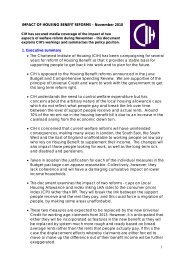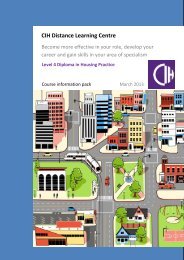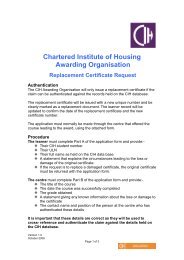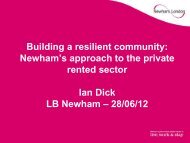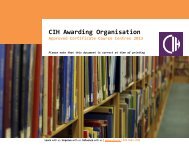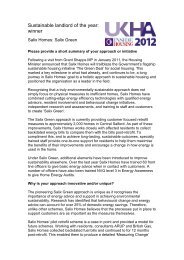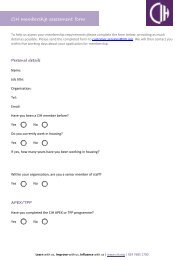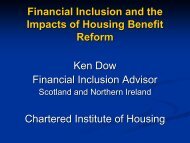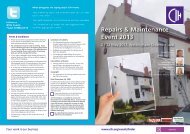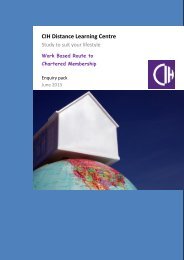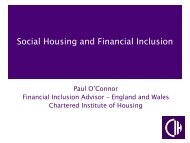View publication - Chartered Institute of Housing
View publication - Chartered Institute of Housing
View publication - Chartered Institute of Housing
Create successful ePaper yourself
Turn your PDF publications into a flip-book with our unique Google optimized e-Paper software.
PART TWO: LEADING TOMORROW<br />
the network and ‘following’ colleagues. It’s about them changing their behaviour, using<br />
the technology to ‘work out loud’ and share what they know.<br />
I’ve been involved in workplace learning for fifteen years and I can’t remember any<br />
programme <strong>of</strong> learning where those attending haven’t said that they learned more from<br />
the other participants than they did from the teacher/tutor/trainer. ESNs provide the<br />
opportunity for large scale informal learning across the organisation by removing the<br />
barrier <strong>of</strong> location.<br />
However, for it to be successful individuals need to adapt their way <strong>of</strong> working, with the<br />
two most common objections being ‘I don’t have the time’ and ‘I don’t know what to<br />
post’. This is because they see using an ESN as an extra thing to do, or an additional<br />
way to communicate.<br />
This is where the convergence <strong>of</strong> work and learning needs to happen. Rather than an<br />
additional task, this is a way <strong>of</strong> reflecting on the work you are doing and the issues you<br />
are facing in an open way, so that others can see it, follow it and contribute to it whilst<br />
it is in process – thus making the link with Siemens’ ‘Principles <strong>of</strong> Connectivism’.<br />
Working out loud<br />
A key concept underpinning the reality <strong>of</strong> a connected workplace is that <strong>of</strong> explicit and<br />
tacit knowledge. Explicit knowledge is that which can be expressed either by speaking<br />
or in writing. Tacit knowledge is that which is contained within the individual and is only<br />
released when a new problem or question is encountered. This is <strong>of</strong>ten an area that is<br />
defined as creative or innovative as people use what they know already to solve new<br />
problems, answer new questions or create new products and services. If you tell others<br />
what you are doing as you work on it, they may ask you a question or give you a<br />
different perspective that leads to a better outcome.<br />
Working out loud is providing a brief running commentary on what you are working on.<br />
Andrew McAfee encouraged people to narrate their work in an article entitled ‘Do’s and<br />
Don’ts for your works social platform’:<br />
‘Talk both about work in progress (the projects you’re in the middle <strong>of</strong>, how they’re<br />
coming on, what your learning, and so on), and finished goods (the projects,<br />
reports, presentations etc. you’ve executed). This lets others discover what you know<br />
and what your good at. It also makes you easier to find, and so increases the<br />
chances you can be a helpful colleague to someone. Finally it builds your personal<br />
reputation and ‘brand’’. 71<br />
144




